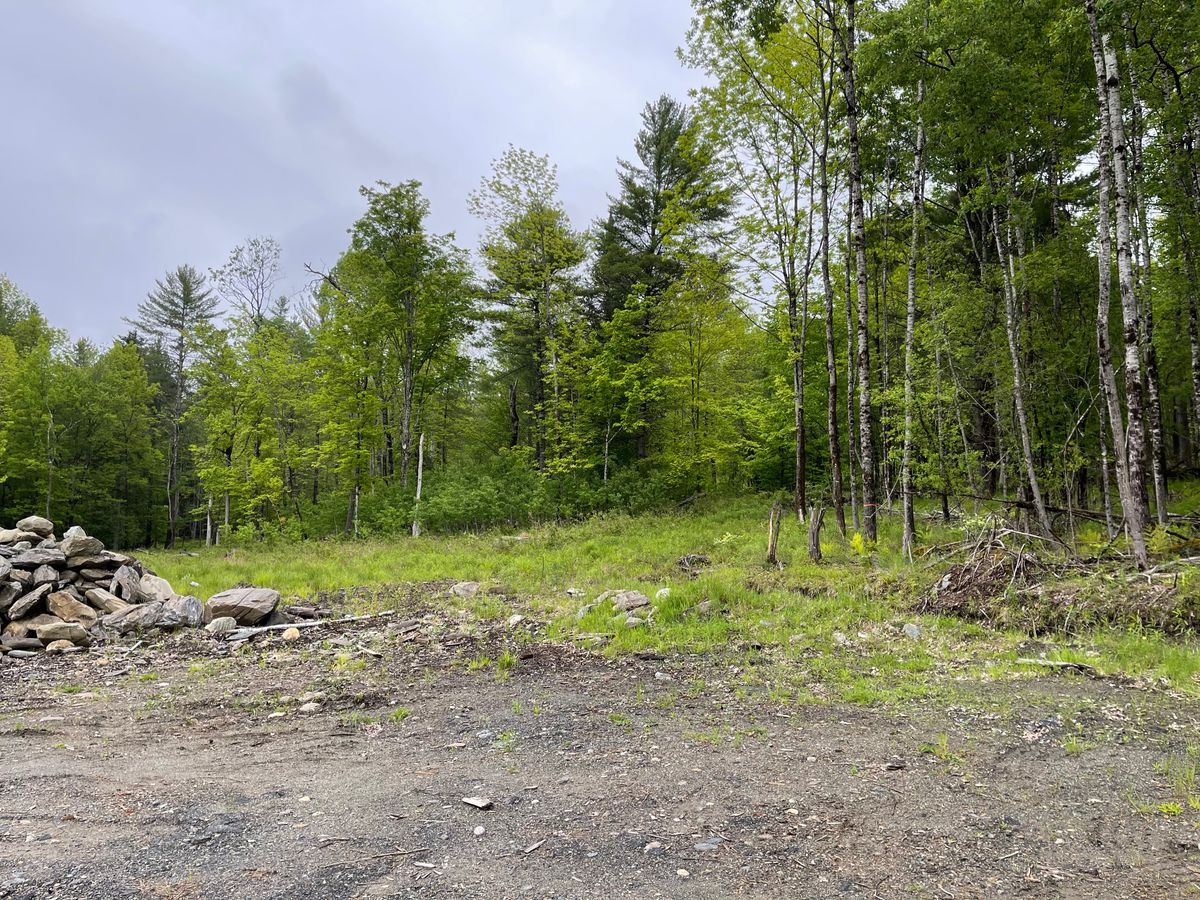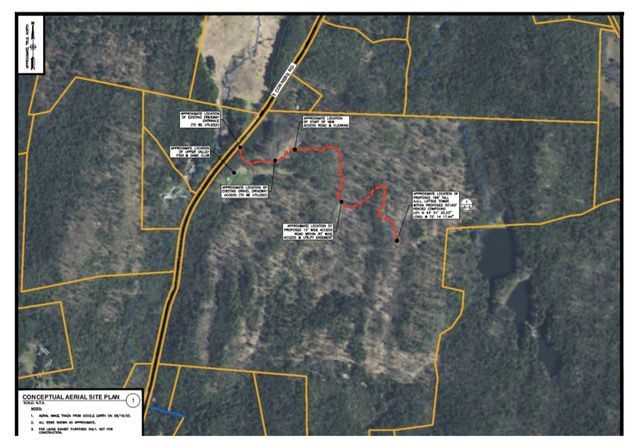ANR seeks conservation near proposed tower, Town stumbles
Nothing has been warned on a Selectboard agenda, but discussions are well underway.

On April 22, 2021, the Agency of Natural Resources (ANR) conducted a visit to the proposed site of an AT&T telecommunications tower on the Town Forest. Their visit highlighted concerns about the impact the development would have on a regional forest block. Collectively, forest blocks are a natural resource that provide many ecological and biological functions critical for protecting native species and the integrity of biological systems. In fact, Act 171 was passed to afford protection to forest blocks in Vermont. As a result of their visit, ANR requested permanent conservation of the southern portion of the Town Forest to ensure the integrity of at least a portion of the forest and offset the impact of the development. The requested conservation would cover 80-90 acres.

While forest blocks have been fragmented or destroyed in other states, Vermont still contains intact blocks. In fact, Vermont is at the center of landscape-scale forested connections in the northeast that allow plants and animals to move east-west from the White Mountains in New Hampshire to the Adirondacks in New York and beyond. They also move north-south through Vermont in a corridor coming down from Canada and into Massachusetts. However, development is encroaching at the edges of intact areas. The proposed tower is but one example.
Climate change underscores the need for corridors, as animals shift their ranges more than ever before. Some are moving in order to survive as their habitats become less suitable. Southern species, like the red-bellied woodpecker and the giant swallowtail butterfly, are becoming resident in Vermont as the state’s extremes of cold vanish. Plants, too, are moving, albeit at a slower pace. One species of oak has extended its range 140 miles north. That’s why it is more important than ever to maintain a connected wild landscape.
The Town Forest is part of a regional forest block and also home to a black ash swamp where a rare, state-listed plant grows. Ash trees throughout the region are threatened by emerald ash borer. Black ash trees in particular are far less numerous than the common white ash, and they only grow in certain types of swamps. They have such important cultural significance to Native Americans, including the Abenaki and Mohawk, that there is an effort to inventory these trees and save their seeds.
While logging operations in 2016-2018 left the extreme southernmost portion of the Town Forest untouched, there was still a sizeable impact on the forest (visible from Google maps). The Town Forest is the only piece of Town-owned acreage that does not have some form of conservation easement. A significant portion of town land, including the Hughes Forest, the Taylor Floodplain Preserve, and the Post Mills Nature Area, is covered by conservation easements. Even conserved land, however, can see timber harvests. It all depends on the terms written into the easement.

The Town became aware that ANR would most likely request conservation as early as the April 22nd site visit, and the specific acreage was defined as early as May 10th. The matter, however, has yet to be publicly warned on a Selectboard agenda. Selectboard Chair Sharon Harkay proposed the Selectboard discuss the matter at its May 17th meeting by making it an agenda addition at the start of that meeting.
Adding items to an agenda at the start of a meeting is allowed by statute. It permits flexibility in addressing last-minute issues that arise after the 48-hour minimum warning period for regular meetings. However, those watching the publicly posted agendas for topics of interest would not be alerted to this discussion or that the Town has begun to take action on the matter.
The Citizens for Responsible Cell Service (CRCS) was paying attention. The group formed last year when AT&T first proposed a tower site on Sawnee Bean Road. In an email to the Selectboard following the May 17th meeting, Jesse Anderson, one of CRCS's co-founders, summarized events over the past year. "The plan was to install the tower on the back of a ridge above the Ompompanoosuc, close to Thetford Center and sited in such a way that the Tower would have loomed over the valley, visible from Thetford Center to Post Mills, as well as Town Hall and many conserved recreation areas that serve our community, such as Bill Hill and Houghton Hill," he wrote.
According to Anderson, CRCS "quickly discovered that due to the vagaries of both Vermont Statute and AT&T's contract with the federal government to build out a mandated first responder network, that the mere fact of the tower was not something that we could control... The more we researched, the plainer it became that Vermont towns have been actively disempowered by statute and the Public Utility Commission (PUC) when it comes to the exertion of any kind of local control over this process."
In 2017 however, the PUC denied a Certificate of Public Good for a proposed tower in the town of Waterbury on the basis of a recommendation from ANR that the proposed site was part of an interior forest block. "To put it more plainly," Anderson wrote, ".. ANR has the power to prevent the use of the Town Forest site, which would effectively kill the Town's deal with AT&T."
Anderson explained that "One important way in which our situation differs from the one in Waterbury is that AT&T has its eye on multiple alternate sites in Thetford, each of which would achieve their stated goals at least as well as the Town Forest location but that would have high visibility and a negative impact on the rural nature of our environment."
The proposed site on the Town Forest offers several solutions, including almost no visual impact on the community as shown by a 2020 balloon test, both from public roads and private residences in the vicinity. The Town Forest location would also be exempt from a tower light, according to the FAA, a benefit that will help reduce migratory bird injuries and fatalities resulting from collisions with the tower. It will also generate yearly lease revenue for the Town of $24,000 with an annual 2% increase, which would reduce the burden on property taxpayers. This benefit would be lost if the deal fell through. And, last but not least, it would increase cell coverage from Route 132 to Lake Fairlee.
Similar environmental concerns, such as the presence of vernal pools, were identified at the other proposed sites as well.
"If [ANR] should make the recommendation that a portion (or all) of the Town Forest be placed in permanent conservation... it would seem a small price to pay to keep the AT&T deal intact," Anderson wrote. He concluded with this: “I would argue that it would actually represent a substantial fringe benefit of the deal. Given the current climate crisis and the projected rate of ongoing global warming, I can't actually think of a better use for the Town Forest than as a protected area. The loss of biodiversity is a shocking result of climate change, and entering the Town Forest into permanent conservation would help to ensure the ongoing health (and existence) of the Town's non-human population. Additionally, protected forests are currently humanity's only effective tool for sequestering carbon, which is critical for slowing the pace of global warming.”
Harkay stated that the discussion was not warned for the May 17th meeting because "we found out about [it] after we made up the agenda.” When Harkay asked the body if it should be added to the agenda, Li Shen responded: "I think we need to get on that, because presumably some final agreement with AT&T... is waiting on this, because AT&T is being told that this needs to happen for everything to fall into place."
Not everyone supported the idea. "If we had conserved this two years ago," Steve Tofel reasoned, "we wouldn't have the opportunity to put the cell tower there now... We're limiting options."
Shen, who attended the April 22nd site visit, explained the importance of the requested conservation, both from an ecological standpoint and in terms of the cell tower negotiations.
"I also went to the [April 22nd] site visit," Harkay said. "It was actually my first time up to the proposed site for the AT&T cell tower... I was utterly surprised, and I have to say dismayed, to see how much development there already is there."
After some discussion by the Selectboard, Town Manager Bryan Gazda added his thoughts: "I do think this is probably just one component of what I think the PUC would look at, and I think that we need to get a better understanding of all the different steps they have go through. I have to agree with Steve... in that, you know, 20 years, 30 years from now that thing could be not being used at all, and you don't want to limit yourself to what you have there... why do we have to give the land to the Upper Valley Land Trust?"
Mary Bryant added, "And I would like to say putting in this connectivity would help hunters. It would help keep a population of many different species in a better situation... When you do log, yes, it can be sort of devastating to look at but it opens up new species of plants, which then brings in new species of animals, and it's just creating a different habitat so there's benefits too to that."
"Bryan, could you get a sense of the timeline for this kind of decision?" Harkay asked. "I think this was a really good discussion that we've had tonight, but we certainly don't have to act on anything tonight."
"I think it's important to get the whole picture," Gazda said. "What's the PUC going to be looking at, because I'm sure there's other agencies that are going to be involved in looking at it." Gazda said he would check with the Town attorney and get back to the Selectboard.
Discussion continued over email after the meeting. Shen shared information related to black ash trees— permissible under Vermont's Open Meeting Law (the distribution of materials for an upcoming meeting)—while Bryant deliberated on the matter in an email to the entire Selectboard, a violation of Open Meeting Law. This violation occurred after the Town, according to Harkay, spent roughly $1,800 in legal expenses related to the Selectboard's difficulty in navigating Open Meeting Law.
In an email update to the Selectboard on May 27th, Gazda reported that the Town attorney will be reaching out to the Upper Valley Land Trust to discuss a conservation easement. "ANR will have to sign off on the environmental review before the PUC will issue the Certificate of Public Good, but there shouldn’t be any other regulatory hurdles that you will have to address," Gazda wrote.
It is unclear where the decision to initiate real estate discussions with Upper Valley Land Trust came from, since the Selectboard can only take action or develop consensus inside the confines of a duly warned meeting. Given that the Town has been aware of the requested conservation for over a month, however, the public should hope to see it as a warned agenda item soon.
